Stephen Morris's Blog, page 27
June 8, 2018
Lidice
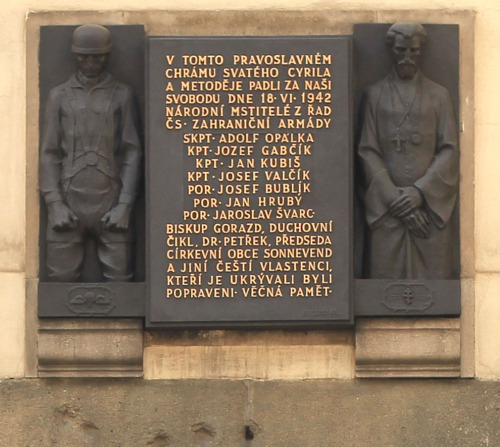
Memorial plaque for Lidice at the Orthodox cathedral of SS. Cyril and Methodius in Prague. A Gestapo report suggested Lidice was the hiding place of the assassins, since several Czech army officers exiled in England were known to have come from there.
June 10, 1942 – In one of the most infamous single acts of World War II in Europe, all 172 men and boys over age 16 in the Czech village of Lidice were shot by Nazis in reprisal for the assassination of SS leader Reinhard Heydrich. The women were deported to Ravensbrück concentration camp where most died. Ninety young children were sent to the concentration camp at Gneisenau, with some later taken to Nazi orphanages if they were German looking. The village was then completely leveled until not a trace remained.
The Nazis destroyed the town by first setting the houses on fire and then razing them to the ground with plastic explosives. They did not stop at that. Instead, they proceeded to destroy the church and even the last resting place – the cemetery. In 1943 all that remained was an empty space. Until the end of the war, the site was marked by notices forbidding entry. The news of the destruction of Lidice spread rapidly around the world.
But the Nazi intention to wipe the little Czech village off the face of the Earth did not succeed. Several towns throughout the world took the name of Lidice in memory of the Czech village that met such a horrific fate. Also, many women born at that time were named Lidice. The once tranquil village Lidice continued to live in the minds of people all over the world and after the war the Czechoslovak government decided to build Lidice again.
You can read the story of the assassination and the reprisals here. A recent movie is an excellent depiction of the historic events.
The post Lidice appeared first on Stephen Morris, author.
June 4, 2018
Well-Dressed Wells
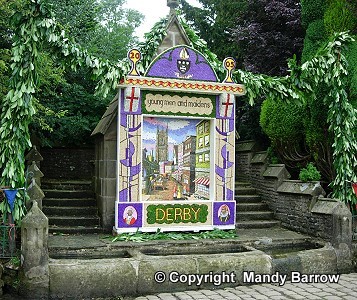
A decorated well in Derbyshire celebrates the fresh well water that allowed communities to survive before modern plumbing.
Romans named the sixth month of the year for JUNO, the queen of the Roman gods and goddesses. But the Anglo-Saxons called it Sera Monath (“Dry Month”) which was as much a hope as a weather prediction. Juno, however, is associated with roses and weddings and that—together with graduations—is what most modern people associate with June.
If June was the Dry Month in Anglo-Saxon areas, then it was important in many places to celebrate the water that was available. People began to celebrate “well dressings” in June to honor the underground springs of fresh water that sustain rural communities and urban neighborhoods. These well dressings are mostly parties now but in ancient or medieval times before plumbing celebrated the survival of communities and neighborhoods thanks to the available water. (See photos of making well dressing decorations here.)
Wells were thought to be the homes of nixies and water sprites, most of whom were friendly but some might be mischeivous or downright nasty to people that came to draw water from the well. Children, however, that fell into the well and drowned were almost always said to have been stolen by the nixie or sprite in the well.
The post Well-Dressed Wells appeared first on Stephen Morris, author.
May 28, 2018
Decoration Day 2018

Originally called Decoration Day, the holiday was created to commemorate the roughly 625,000 Union and Confederate soldiers who died during the Civil War.
Memorial Day, the holiday which many in the US consider the beginning of summer, was originally known as “Decoration Day” and was the commemoration of those fallen in battle — at first, those who had fallen in the battles of the Civil War and then those who had fallen in any battle. People went to the burial grounds to decorate the graves of the fallen with flowers and banners. They might also have picnics, an American variation on the ancient “memorial meals” held in honor of the dead.
Decorating graves and meals to mark certain anniversaries of death were common in Greek, Roman, and Jewish, as well as early Christian, societies. One of the benefits of joining a burial society or club in classical Rome was that the club members were obligated to hold meals in honor and memory of the deceased. Sometimes food was left atop the grave for the departed, as well as shared among the living. It was these annual memorial meals at the gravesides of the dead that eventually became the annual saints days to mark the “birthday into heaven” of the dead.
Graves would be decorated not only to mark the burial site but to appease the dead as well, who might come back to harass their heirs for neglecting their graves. Flowers, a marker of life, were among the most common means of appeasing the dead although more substantial and permanent decorations — such as carvings, headstones, or statues — were used by the wealthy.
Nowadays often considered a scary or forbidding location, graveyards and cemeteries were common places for communities to gather. Over the centuries, many rules developed to curtail dancing, markets, drinking, and parties among the graves which only means that people kept dancing and drinking and holding markets or parties among the dead. No one makes rules against things that don’t happen, after all.
This year, how many Americans will mark the unofficial beginning of summer by visiting a graveyard?
The post Decoration Day 2018 appeared first on Stephen Morris, author.
May 21, 2018
Invention of the Cross
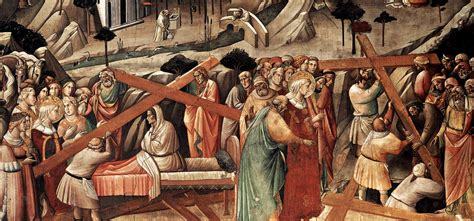
St. Helen tests the crosses she discovers during the excavations of Golgotha in Jerusalem.
St. Helen, the mother of the Emperor Constantine, is said to have discovered the True Cross in Jerusalem. (Because her son Constantine has seen a vision of the Cross when God promised him victory, locating and honoring the Cross was important to her.) Her discovery is known as the “Invention of the Cross;” the word invention means discovery, not just that someone invented or made up something that did not exist before.
The legend says that Adam was buried on a hill near what became the city of Jerusalem and that the hill became known as Golgotha. Adam’s son was given a seed from the Tree of Life in Paradise to plant in Adam’s grave. The seed grew into a tree whose fruit healed the sick. But eventually the tree was cut down and the lumber used for building projects. Some of it was used to build a bridge into Jerusalem and when the Queen of Sheba came to visit Solomon in Jerusalem, she realized how special the wood in the bridge was. She got down off her horse and bowed down in reverence to the wood before going across it. Later, when Jerusalem fell into ruin, the bridge collapsed. Much later, the Roman soldiers found the planks from the old bridge and used them to build the cross that Jesus was crucified on. So the lumber from the seedling of the Tree of Life became the Cross and the blood of Christ, the Second Adam, sprinkled Adam’s bones deep within Golgotha.
(The imagery in this legend expresses in poetic form a lot about the Cross—the ultimate Tree of Life—that is true but difficult to express otherwise. Bridges were metaphors for spiritual and religious practice that enable a person to transcend sin or earthly limitations; “pontifex,” the Latin word for “bridge-builder” also came to mean “priest.” The Queen of Sheba reverenced the material through which God would act to save the world; she is also associated with bringing the Ark of the Covenant (a metaphor for the Incarnation and the role of the Virgin Mary as Mother of God) to Africa for safekeeping—so the Queen of Sheba is twice associated with the ways God uses matter to save the world. The death of the Second Adam on Golgotha released the First Adam and all of us who are Adam’s children.)
When Jerusalem became a Roman city in the 2nd century AD, a temple for Adonis was built atop Golgotha. This helped identify Golgotha and the local Christians never forget what had happened there before the temple had been built. So when St. Helen came to Jerusalem in the early 4th century AD to excavate places important during Jesus’ life, the local Christians could tell her where to begin excavating to discover the place of the Crucifixion.
St. Helen began excavations and found three crosses beneath the temple. She had three sick men brought and touched the crosses to them. Two of the crosses did not heal the sick. One did. She had three dead men brought and the cross that had healed a sick man also raised a dead man.
The cross that healed the sick and raised the dead was identified as Jesus’ cross. It is also said to have been surrounded by lots and lots of basil plants; basil is therefore thought to protect against curses. It is also used to decorate the Cross in churches on feast days and to sprinkle holy water on the faithful coming to celebrate festivals in honor of the Cross.
The post Invention of the Cross appeared first on Stephen Morris, author.
May 14, 2018
Werewolves, Weasels, Ravens—O, My!

Tomatoes were an important ingredient in some potions that would turn someone into a werewolf.
Everyone knows about the connections between werewolf bites, wolfbane, silver bullets, and the full moon. “Thank you, Hollywood!” But the real connections between werewolves, tomatoes, and other legends is actually more interesting although less well known.
The most famous werewolf story in Norse mythology–but almost unknown anywhere else–is the story of father and son, Sigmund and Sinfjotli. Wandering in the woods, Norse heroes Sigmund and Sinfjotli come upon a hut where they find two spellbound wolf pelts. Sigmund and Sinfjotli put on the pelts and then discovered that the pelts could only be removed every 10th day and therefore wander in forest as wolves.
Sinfjotli & Sigmund agree to fight together if attacked by more than 7 men but Sinfjotli the son kills 11 men at one time. Sigmund fatally injures his son. But a raven, the messenger of Odin, brings a healing leaf to place on Sinfjotli’s wound. (Some versions of the story say that a pair of weasels bring the healing leaf.)
Sinfjotli is healed, he and his father take off the wolf pelts as the 10th day comes and burn the pelts to free themselves.
It is not a surprise to meet a raven, associated with Odin and death, around werewolves. Weasels, generally thought sneaks and thieves, are also considered extremely talented physicians in traditional tales. Using a magic wolf pelt to become a werewolf is also common in folklore. But the stipulation that the pelt can only be removed 10 days after it is put on is unusual. Perhaps the ten days, which is approximately 1/3 of a lunar month, is a Norse version of the connection between werewolves and the moon.
The post Werewolves, Weasels, Ravens—O, My! appeared first on Stephen Morris, author.
May 7, 2018
Beating the Bounds

This 1967 Rogation procession in England to pray for the crops would have originally involved “beating the bounds” to mark the boundaries of the parish.
Throughout Europe on Ascension Day (the 40th day after Easter, always a Thursday) there was an ancient custom of “beating the bounds” to mark the limits of each parish (community). There were also processions through the local fields on the 3 days called “Rogation” that same week; sometimes the “beating of the bounds” was combined with the Rogation processions.
In England, the custom of beating the bounds goes back at least as far as the Anglo-Saxon period. In the days before maps and written title deeds a knowledge of the physical boundaries of property was very important. So the custom grew up of walking the boundaries, stopping at intervals to strike boundary stones to ‘mark’ the bounds. (Originally, probably it was the boys and young men that were beaten so that they would remember where the boundaries of the parish were located.) The practice was often linked to Rogation Days, the Monday-Tuesday-Wednesday before Ascension set aside by the Church for prayers for the crops; walking the boundaries of the parish was an obvious opportunity to “beat the bounds” and pray for the crops at the same time.
In England, between 1598 and 1834, the care of the poor was the responsibility of each parish church. It was the local parish (community) that had to relieve the needy, apprentice children and care for the destitute. The responsibility was for all those settled in the parish; this included illegitimate children, which sometimes led to parish officials trying desperately to remove pregnant unmarried women to another parish so that they would not be responsible for the baby! The Poor Laws provided another reason for ensuring that everyone knew the boundaries of the parish. The inhabitants needed to know which authorities to apply to for help, and the authorities to know which inhabitants were entitled to that help.
There are still processions to “beat the bounds” in Oxford as well as in London!

Breton Blessing of the Wheat at Artois (1857)
The post Beating the Bounds appeared first on Stephen Morris, author.
April 30, 2018
“May Day 2018!”

Queen Guinevere, as the May Queen, leads the May Day celebrations in Camelot.
Considered the first day of the summer season in traditional European societies, the first day of May has been celebrated in many ways over many centuries. May Day is related to the Celtic festival of Beltane and the Germanic festival of Walpurgis Night. May Day falls half a year from November 1 (Samhain, Hallowe’en, and All Saints’ Day) and it has traditionally been an occasion for popular and often raucous celebrations.
The earliest May Day celebrations appeared in pre-Christian times, with the festival of Flora, the Roman goddess of flowers, and the Walpurgis Night celebrations of the Germanic countries. It is also associated with the Gaelic Beltane. Many pagan celebrations were abandoned or Christianized during the process of conversion in Europe. A more secular version of May Day continues to be observed in Europe and America. In this form, May Day may be best known for its tradition of dancing the maypole dance and crowning of the Queen of the May. Fading in popularity since the late 20th century is the giving of “May baskets”, small baskets of sweets and/or flowers, usually left anonymously on neighbors’ doorsteps. (I remember making May Baskets in school and field day Maypoles on the playground.)
The day was a traditional summer holiday in many pre-Christian European pagan cultures. While February 1 was the first day of Spring, May 1 was the first day of summer; hence, the summer solstice on June 25 (now June 21) was Midsummer.
In Oxford, it is traditional for May Morning revellers to gather below the Great Tower of Magdalen College at 6:00 a.m. to listen to the college choir sing traditional madrigals as a conclusion to the previous night’s celebrations.
On May Day, the Romanians celebrate the arminden (or armindeni), the beginning of summer, symbolically tied with the protection of crops and farm animals. The name comes from Slavonic Jeremiinŭ dĭnĭ, meaning the prophet Jeremiah’s feast day, but the celebration rites and habits of this day are apotropaic and pagan, possibly originating in the cult of the god Pan.
The day is also called ziua pelinului (mugwort day) or ziua bețivilor (drunkards’ day) and it is celebrated to insure good wine in autumn and, for people and farm animals alike, good health and protection from the elements of nature (storms, hail, illness, pests). People would have parties outdoors with fiddlers and it was customary to eat roast lamb, as well as new mutton cheese and drink mugwort-flavoured wine to refresh the blood and get protection from diseases. On the way back from the parties, the men wear lilac or mugwort flowers on their hats.
Other May Day practices in many places include people washing their faces with the morning dew (for good health) and adorning the gates for good luck and abundance with green branches or with birch saplings (for the houses with maiden girls). The entries to the animals’ shelters are also adorned with green branches. All branches are left in place until the wheat harvest when they are used in the fire which will bake the first bread from the new wheat.
The post “May Day 2018!” appeared first on Stephen Morris, author.
April 23, 2018
St. George and the Werewolves

Icon of St. George killing the dragon from the late 1400s.
St. George is probably best known for killing the dragon. But there are many other legends and customs associated with the celebration of St. George’s Day on April 23 or the night before (St. George’s Eve). One of the most mysterious is that of the Master of the Wolves. On St. George’s Eve a man is wandering in the forest, becomes tired, and climbs into a tree to rest. He falls asleep. When he awakes, he sees the Master of the Wolves below him, who is giving out food to the wolves or werewolves, sometimes sending them in all directions to search for food. The last in line is the Lame Wolf. Since there is no more food, the Master of the Wolves says he can eat the man watching from the tree.
Among part of the southern Slavs (Serbs, Macedonians, Bulgarians) the legends and beliefs about the Master of the Wolves are also connected with numerous commandments, prohibitions and customs associated into the so-called “wolf holidays”. Legends about some type of Master of the Wolves can also be found in written form among the majority of southern and eastern Slavs, partially also among the Poles, and among the Estonians, the Gagauz in Moldavia, in Latvia, Romania and in an incomplete form even in France. His function, as can be established from the legends and beliefs, is to lead the wolves and determine what they may and may not eat. In some versions of the legend, the Master of Wolves is St. George himself! (For more about the Master of Wolves, read here.)
In the book Dracula, by Bram Stoker, evil things are said to occur on St George’s Day, beginning at midnight. The date of St George’s Day presented in the book, 5 May (on the Western, Gregorian calendar), is St George’s Day as observed by the Eastern Orthodox churches of that era:
“Do you know what day it is?” I answered that it was the fourth of May. She shook her head as she said again: “Oh, yes! I know that, I know that! but do you know what day it is?” On my saying that I did not understand, she went on: “It is the eve of St. George’s Day. Do you not know that tonight, when the clock strikes midnight, all the evil things in the world will have full sway?”(Excerpt from Dracula, 1897)
The post St. George and the Werewolves appeared first on Stephen Morris, author.
April 17, 2018
Good King Wenceslaus and the Apocalypse

The casket containing the relics of St. Wenceslaus in the chapel of the Prague cathedral. (photo by S. Morris)

Looking across the St. Wenceslaus chapel in the Prague cathedral; note the wooden door taken from the church where St. Wenceslaus was murdered . (photo by S. Morris)

Looking into the chapel of St. Wenceslaus in the Prague Cathedral. (Photo by S. Morris)
The chapel of “Good King Wenceslaus” in the Prague cathedral is a dazzling display of both royal and apocalyptic glory! The good king–perhaps best known for his Christmas carol was actually the duke of Bohemia but he was the functional equivalent of a king–was murdered by his pagan brother Boleslav in AD 935. Wenceslaus (in Czech, his name is “Vaclav”) was murdered by hired killers as he was arriving at a country church for the baptism of his nephew, Boleslav’s son; Boleslav had invited Wenceslaus to be the boy’s godfather as a pretext to get Wenceslaus out into the country so that he could be more easily murdered. Boleslav seized the throne and was a cruel, hedonistic ruler. He died in AD 967, after ruling for more than 30 years. But he was forced by popular opinion to have his brother Wenceslaus’ body brought back to Prague in AD 938 and buried in a small church near the castle. Wenceslaus was acclaimed as a saint.
The famous emperor Charles IV–who built the great Charles Bridge as well as many of the beautiful buildings that we still see in Prague–had a chapel built for the relics of St. Wenceslaus in the new cathedral of St. Vitus that was being built in the 1300s.
The design of the chapel is based on the description of the heavenly Jerusalem in the Apocalypse, commonly known as the Book of Revelation. The chapel is square, just as the heavenly city was described, rather than rectangular. The walls of the chapel are studded with the precious jewels the walls of the heavenly city were said to be built with. There is a small door in one corner which leads to a stairway which leads to a small room in which the crown jewels are kept; this door has seven locks and the seven keys–held by various important officials in the government and cathedral staff–are needed to open it. These seven locks and keys are based on the locks and keys held by seven archangels in the Book of Revelation. The windows of the chapel fill the square room with light just as the Heavenly Jerusalem was said to be filled with light. The massive doors to the chapel are the same doors of the country church that Wenceslaus was entering as he was murdered by his brother.
The chapel of St. Wenceslaus reproduces the splendor of the heavenly Jerusalem because the saints are thought to be the first citizens of the New Jerusalem. The first saints said to inhabit the heavenly city are the martyrs–those killed for their faith–and St. Wenceslaus is the first martyr of the Czech region. He was also thought to be the perfect model of a good king who cares for his people more than for himself and the living image of Christ the King who gives up his life so that his people might live. When I was in Prague in early April, I was struck again by the stunning beauty of the entire cathedral and of the chapel of St. Wenceslaus in particular.

Chapel 1
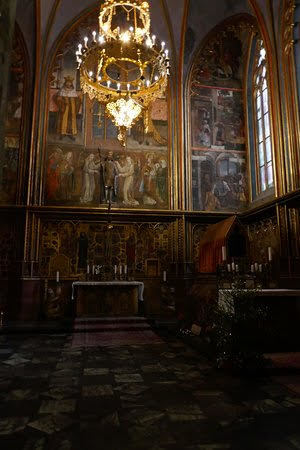
Chapel 2

Chapel 3

Chapel 4
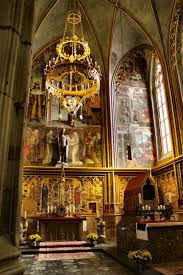
Chapel 5
The post Good King Wenceslaus and the Apocalypse appeared first on Stephen Morris, author.
April 6, 2018
Now is Your Chance! PRAGUE? Here We Come!

Prague, currently among the cheapest vacation spots in Europe, is waiting for YOU!
Quick! Book your tickets! If you have not seen Prague yet, NOW is your chance! The Prague Post reports that because of the strength of the US Dollar in currency markets, Prague is currently among the cheapest European vacation destinations in Europe. You can use the Come Hell or High Water books as guides to the local historical sites (the Old Town Square, the Little Town across the river, the spectacular Charles Bridge, the castle-cathedral complex of buildings — including Golden Alley — overlooking the city) as well as the WONDERFUL self-guided walking tours that you can find here.
I will be there for a week in early April that is part-vacation and part-research for a new novel set in 1600s Prague. At that time, Prague was one of the main business contacts between Western Europe and the Moslem Turks; it was also one of the most important “black markets” of castrated European men sold to the Turks as eunuchs. There are several tales in Prague about Turkish ghosts from that period. A novel set in that period will give me the chance to explore Turkish and Muslim folklore and magic as well as Czech folklore and magic.
I have never been disappointed by Prague’s beauty, no matter what time of year I arrived. This is your chance to stay in the Biskupsky Dum hotel (where Elizabeth, the Dearg-due killed a victim or two), walk along the Charles River (where both a tourist and an Evil Conference professor each met a bad end), and stand in the plaza at the apse-end of the cathedral where Svetovit was worshipped with the sacrifice of black rooster.
Or just bring me along with you as your private tour guide!



